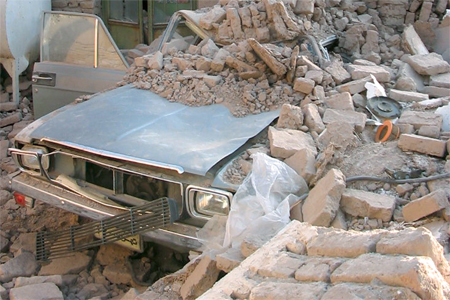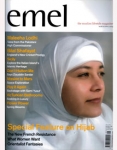
The Earth's Tremor
Issue 4 Mar / Apr 2004
The devastating recent earthquakes in Iran and Morocco highlight the ferocity of natural disasters. Hafeez Khan explores the nature of the earth's tremor and finds out how, why and where they happen and whether the most vulnerable parts of the world can be better equipped for such a catastrophe.
"When the earth quakes with her mighty quaking, when the earth yields up her burdens, and man cries out, what has happened to her" Surah Al-Zalzala {99: I-3}
On Friday 26th December 2003 a huge earthquake in south-eastern Iran measuring 6.7 on the Richter scale claimed an estimated 40,000 lives. The quake had its epicentre near the ancient city of Bam and occurred in the early morning. Many of the city and surrounding area’s 200,000 inhabitants were sleeping when the quake struck and it is thought the majority of casualties were crushed as they slept. Iranian State Television reported that 70% of the houses in Bam were destroyed, two of the city’s hospitals collapsed and in the aftermath of the quake, the city’s remaining hospitals were full to bursting point.
Islamic Relief’s Adeel Jafferi travelled to Bam days after the quake. “The devastation was apparent from the moment we flew into Bam airport with the plane landing without the aid of computer controlled airport technology because the systems had been destroyed. Beyond the airport the streets looked like a war zone with people living in tents and make-shift homes. Soon after we arrived there was an aftershock which was a frightening experience but it then became such a regular occurrence that we got used to it.
The mood of the city was stark and sombre with everyone in mourning, everyone had lost someone. Half the population of the city had been annihilated in five seconds. I met a 96 year old woman who had lost 45 members of her family – children, grandchildren, nephews, nieces. But despite the scale of the tragedy there was also a feeling of hope and destiny among the people of Bam. Many drew on their faith and viewed this as God’s will, as a test.
I was very moved by the spirit of generosity and hospitality that I and the other foreign aid workers were greeted when we arrived in Bam. This is usual in many Muslim countries but particularly poignant given the situation. These people had lost everything, yet they wanted to share what little they had with us – offering us meals and undertaking such acts of generosity that I was humbled. There was a strong sense of community with newly orphaned children and elderly people being taken in by other families and everyone looking out for each other.
When we arrived, initially there was some inevitable chaos as people were doing what they could in extraordinary circumstances. The Iranian authorities were very helpful and wel co-ordinated which made the situation that much more manageable. The first goal was to deal with the emergency situation, however,our long-term aim is the re-development of the city. The government of Iran is undertaking stringent measures to re-create Bam to withstand seismic activity so, God willing, such a tragedy will not be repeated. Also, Islamic Relief is working in partnership with an organisation run by Iranian Nobel Peace Prize winner Shirin Ebadi to set up a day center to meet the emotional and psychological needs of traumatised children and adults. After the immediate situation has been stabilised and the buildings re-built, the people still have to pick up the pieces and allow normality to return to their lives. We hope to help them towards such normality”
According to Dr Ahmed Elghazouli who is Reader in Engineering Structures at Imperial College and specialises in earthquake engineering, “We have developed two ways of limiting damage to structures in the event of an earthquake. The first is to reduce the vibrations experienced by a building through the use of sophisticated dampers and vibration control systems. However, this is expensive so it is far better to accommodate the eventuality of an earthquake in the actual design of a building.
We study the seismic activity of an area which gives us an idea of the likelihood of an earthquake occurring. We also take into account the importance of the building so we would design a hospital in an area vulnerable to earthquakes in such a way that the level of damage is minimal in the event of a large quake. A power plant would be designed with the expectation that there should be no damage as it is vital to keep it running.
To help us design durable buildings we have to understand the behaviour of structures so we undertake extensive fieldwork and go out to places where an earthquake has occurred. We then examine the scene and find out what damage occurred and why. This is how we can learn from disasters and improve the design of buildings. In our work there is a constant balance between safety and economy coupled with the probability of an earthquake occurring– these are the factors that help us decide how earthquake-proof we will make a certain structure.
In Iran there are very good building regulations and an abundance of scientific expertise , however the enforcement of the codes is the problem and is why buildings collapse. The supervision of quality control is often not rigorously enforced, particularly in developing countries, thus resulting in such needless loss of life.”
As well as the tragic human suffering, the world lost a unique site of archeological significance when the earthquake struck. Bam is 1000 kilometres (620 miles) south-east of Tehran and was on the Unesco's list of World Heritage Sites making it also one of the country’s most popular tourist spots. An important regional centre in the 16th and 17th centuries, it contained many ancient buildings that were not built to withstand earthquakes. Its 2000 year old mudbrick citadel is reported to have been destroyed.
Constructed out of mud bricks, clay straw and the trunks of palm trees, it is said to have been the largest structure of its kind in the world.
How Do Earthquakes Happen?
An earthquake is a shaking of the ground caused by movements beneath the earth’s surface. The earth’s surface is made up of an outer layer of rocks called its crust. The crust is made up of huge pieces called tetonic plates that fit together like a jigsaw puzzle. The plates move slowly while pushing, pulling and colliding with each other. When the plates rub together, known as a fault, great strain is placed on the crust as waves of seismic energy are forced to come to the earth's surface. Large faults cause splits in the ground as areas of land are pushed up or sink, resulting in an earthquake. Earthquakes are often followed by aftershocks. These are smaller quakes which bring more damage to already weakened buildings and roads and can result in further devastation.
Where Do Earthquakes Occur?
We now know that three-quarters of the world’s earthquakes occur in a zone around the Pacific Ocean called the ‘Ring of Fire’. Another earthquake belt runs across southern Europe and Asia, from the Middle East and the Himalayas to Indonesia. The two great earthquake belts meet near the island of New Guinea. There are three types of areas where fault lines can be found and earthquakes occur.
Spreading zones are the scene of molten rock rises, pushing two plates apart and adding new material at their edges. Most spreading zones are found in oceans; for example, the North American and Eurasian plates are spreading apart along the mid-Atlantic ridge.
Transform faults are found where plates slide past one another. An example of a transform-fault plate boundary is the San Andreas fault, along the coast of California and northwestern Mexico.
Subduction zones are found where one plate overrides, or subducts, another, pushing it downward into the mantle where it melts. An example is found along the northwest coast of the United States, western Canada, and southern Alaska and the Aleutian Islands.
Can We Be Better Prepared?
It is difficult to predict earthquakes, however modern technology and satellite images have been used to detect the tiniest ground movement. Scientists have also found patterns in gas and mineral levels immediately before an earthquake as rocks are compressed. Due to research into fault lines, we are aware which areas are vulnerable to earthquakes. Building design is also a factor. In December 2003 an earthquake measuring 6.5, similar in magnitude to Iran, rocked the US from Los Angeles to San Francisco. Yet the death toll was less than ten because, unlike Bam, buildings were built to withstand earthquakes.
If you would like to donate money to help the victims of the Bam earthquake you can contact the following UK and international charities:
Islamic Relief, www.islamic-relief.com,
+44 121 622 0622 (worldwide)
The Red Cross,
www.redcross.org.uk/disaster_fund,
020 7201 5040
Islamic Aid,
www.islamicaid.org.uk, 0845 130 8990
Muslim Hands,
www.muslimhands.com, 0115 9117 222
Merlin,
www.merlin.org.uk, 020 7378 4888
Islamic American Relief Agency,
www.iara-usa.org,
1 800 298-119900) 298-1199
Mercy International
USA, www.mercyusa.org, 1-800 556-3729
Global Relief Foundation,
www.grf.org, 1-888-256-2532
Bookmark this |
|
Add to DIGG |
|
Add to del.icio.us |
|
Stumble this |
|
Share on Facebook |
|
Share this |
|
Send to a Friend |
|
Link to this |
|
Printer Friendly |
|
Print in plain text |
|


Comments
0 Comments